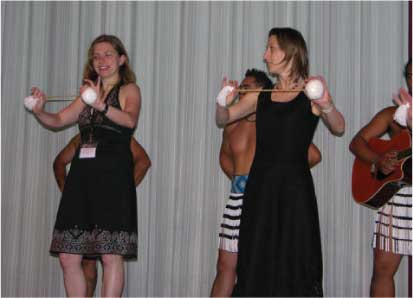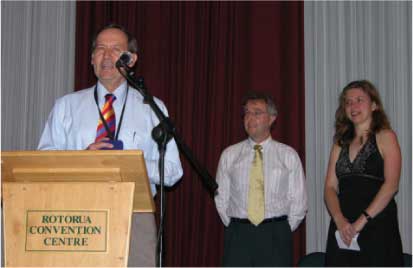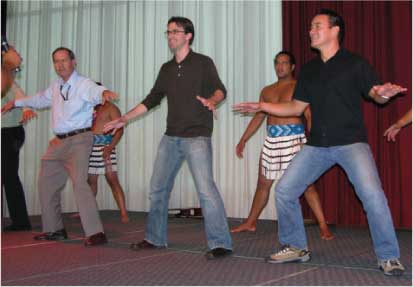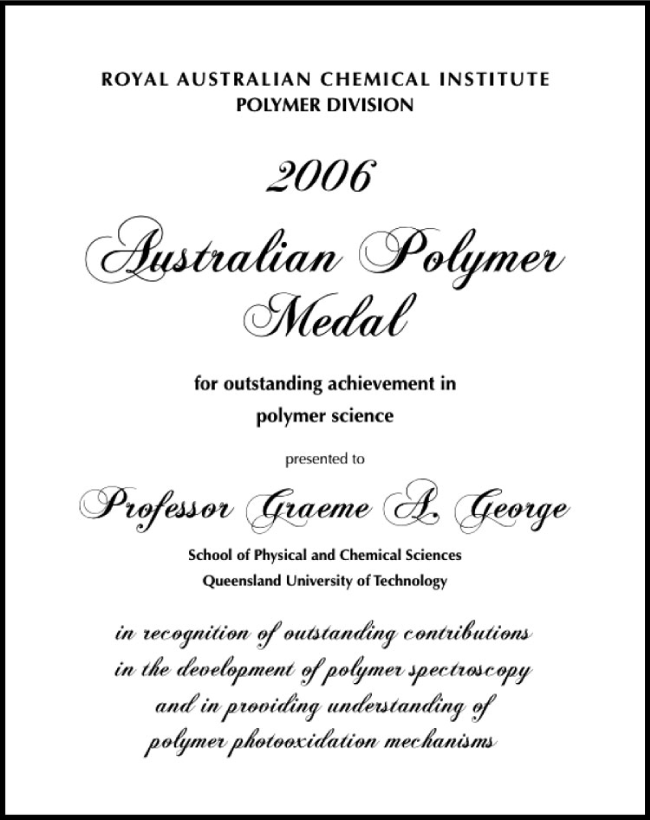When Harry Met Sally: Polymer Chemistry Meets Biomaterials
Gregory T. Russell A and Martina H. Stenzel BA Department of Chemistry, University of Canterbury, Christchurch, New Zealand. Email: greg.russell@canterbury.ac.nz
B Centre for Advanced Macromolecular Design (CAMD), School of Chemical Science and Engineering, University of New South Wales, Sydney NSW 2052, Australia. Email: m.stenzel@unsw.edu.au

Greg Russell is currently an associate professor in chemistry at the University of Canterbury in Christchurch, New Zealand. In 1986 he graduated from the University of Sydney with First Class Honors and a University Medal in Physical and Theoretical Chemistry. He then went on to obtain his Ph.D. from the same university, his thesis topic being ‘Diffusion-Controlled Polymerization Reactions’. In 1991 he accepted an Alexander von Humboldt Postdoctoral Fellowship and for the next three years he worked at the University of Göttingen, Germany; through annual return visits, it has become a home away from home for him. Since 1994 he has been a staff member in the Department of Chemistry at the University of Canterbury. His present research interests are the kinetics of free-radical polymerization, emulsion polymerization, and polymer synthesis. From December 2004 to February 2006 he was Chair of the RACI Polymer Division; he has survived to tell the tale. |

Martina Stenzel is currently a senior lecturer at the University of New South Wales in Sydney, Australia, and is associated with the Center for Advanced Macromolecular Design (CAMD). She spent her undergraduate years in Bayreuth, Germany, and completed her Master’s degree in chemistry in 1996. After finishing her Ph.D. in 1999 at the University of Stuttgart, Germany, she came to Australia as a postdoctoral fellow sponsored by the German Academic Exchange Service (DAAD). After she discovered the beautiful lifestyle in Australia, she decided never to return to the cold German winters and took up an academic position at the University of New South Wales in 2002. In her research she is interested in the interface between polymer and biomedical science, focussing mainly on the synthesis of carriers for drug delivery. |
Australian Journal of Chemistry 59(8) 477-480 https://doi.org/10.1071/CH06294
Submitted: 14 August 2006 Accepted: 14 August 2006 Published: 8 September 2006
It is the dramatic moments of a conference that linger long in the mind. At the Australasian Polymer Symposium held in Rotorua, New Zealand, over 5–9 February 2006, one such moment came during Graham Parker’s plenary lecture on ‘Stem Cells: Have the Shibboleths of Development Yet Found Their Niche?’ Recounting the history of research into stem cells, Graham came to late 2005, when notoriety turned science into front-page news around the world: Hwang Woo-Suk’s claims to have created several human embryonic stem cell lines were shown to be fabricated.* Graham treated this awkward moment simply by saying ‘And then’, before standing aside in silence as his PowerPoint display clicked over to show a cartoon of a spinning fan. Indeed, this left no need for anything to be said.
What there is a need to say something about is the conference itself. First, how is it that a talk on stem cells by a medical researcher could infiltrate and ignite a conference on polymer science? The answer is that the conference was far more than just this: it was the combined 28th Australasian Polymer Symposium and Australasian Society for Biomaterials 16th Annual Conference. This is not the first time that the RACI’s Polymer Division and the ASB have flirted with each other — the two societies held their meetings concurrently in Beechworth, Victoria, in February 2001. But whereas that was just a getting-to-know-you, in Rotorua there was a jumping-into-bed-together with commitment: The two meetings had a completely integrated program, including a full day devoted exclusively to the interface between polymer science and biomaterials. This Special Issue, consisting of contributions from about half the plenary and invited speakers at the conference, reflects the varied but harmonious program that was achieved — there are papers by Igor Lacík,[1] Justin Cooper-White,[2] Jan van Hest,[3] and Bob Gilbert[4] from the ‘interfacial’ day, Graham Parker[5] and Dietmar Hutmacher[6] are from the biomaterials program, while Bernadette Charleux[7] (see Fig. 1), Graeme George[8] (Figs 2 and 3), Michael Coleman,[9] Eva Harth,[10] Martina Stenzel[11] (Figs 1 and 3), Richard Laine,[12] Philipp Vana,[13] Christopher Bowman,[14] and Roger French[15] were speakers in the polymers program. But as is clear from our opening anecdote, even the nominally specialist talks tended to be of widespread interest; for example, almost all the above-mentioned contributions from polymer scientists point to (nano)materials applications also of interest to biomaterials workers.

|

|

|
This observation foreshadows the answer to another obvious question: Why would polymer and biomaterials scientists want to confer together? It is often remarked that the 20th century was the century of the (synthetic) polymer, and it is also often remarked that the 21st century will be the century of biology. Therefore it follows that the immediate future is biomacromolecular. To stimulate and facilitate such frontier research, both scientific societies were enthusiastic to meet together; that we correctly read the Zeitgeist is reflected not just in the attendance of over 330 delegates at the conference, but also in the size of this Special Issue.
Which brings us to the Australian Journal of Chemistry. The origins of this Special Issue are to be traced to Vol. 55, No. 6 & 7†, a Special Issue from the 25th Australasian Polymer Symposium in 2002. It has become one of the most cited issues of Aust. J. Chem., so it is highly appropriate that this exercise is being repeated, and it is gratifying to see polymer scientists publishing en masse in Aust. J. Chem. once again. As in 2002, this project has been driven by the enterprise and enthusiasm of indefatigable Aust. J. Chem. editor Alison Green, who has also brought it all together with her characteristic professionalism — we thank her for all this. We would also like to express gratitude to Alison for the close relationship that she has forged between Aust. J. Chem. and the RACI Polymer Division, not just in the form of these Special Issues, but also through Aust. J. Chem.’s ongoing sponsorship of the Treloar Prize. This is for the best oral and poster presentations by workers under the age of 30 at Australasian Polymer Symposia. We congratulate the winners from 2006, who were Emma Prime of the University of Queensland, Kok Hou Wong of the University of New South Wales, and Greg Smith of the University of Canterbury (of course it was purely coincidental that the latter two students are supervised by your guest editors!). For some details on the work of Emma and Kok Hou, see the papers they have contributed to this Special Issue.
Which leads us to other prizes awarded in Rotorua. Preeminent among these was the Australian Polymer Medal, for outstanding (lifetime) achievement in polymer science in Australia. Graeme George (see Fig. 2) of the Queensland University of Technology became just the ninth winner of this most esteemed award of the RACI Polymer Division, his citation reading ‘in recognition of outstanding contributions in the development of polymer spectroscopy and in providing understanding of polymer photooxidation mechanisms’ (Fig. 4). We congratulate Graeme on this award and refer readers to the excellent review he has contributed to this issue. We also congratulate other award winners from Rotorua: Frank Caruso (University of Melbourne), who was honored with the Australian Polymer Science and Technology Achievement Award, which recognizes individual achievement in the science or technology of polymers by a researcher under the age of 40; and David Lewis (SOLA R&D, Carl Zeiss Vision) and Brian Hawkett (University of Sydney), who were recognized with Citations for their scientific and commercial achievements and for their services to the Polymer Division.
We now end as we began, by recounting a dramatic moment. In fact the Maori cultural performance that was part of the conference banquet provided multiple memorable moments (Figs 1 and 3). It is Fig. 3 we would like to focus on. Who could forget the sight of Graeme George performing the haka, eyes bulging and neck veins pulsating as if he was Wayne ‘Buck’ Shelford‡ (notwithstanding that tennis is his family’s sport — he is a cousin of Geoff Masters, the former Australian Davis Cup tennis player!). While the spectacle of the haka is widely recognized, the real reasons for carrying it out are as recognition of the importance of an occasion and as motivation to greater efforts.¶ In these senses its performance at our conference by Graeme and others, on behalf of all delegates, was highly symbolic: We must embrace the important challenges posed by the frontier between polymers and biomaterials, for the better future of the world depends on it. If you doubt this, just read within on developments into stem cells, artificial pancreases, and bone implants, to name but a few examples.
[1]
I. Lacík,
Aust. J. Chem. 2006, 59, 508.
| Crossref | GoogleScholarGoogle Scholar |
| Crossref | GoogleScholarGoogle Scholar |
| Crossref | GoogleScholarGoogle Scholar |
| Crossref | GoogleScholarGoogle Scholar |
| Crossref | GoogleScholarGoogle Scholar |
| Crossref | GoogleScholarGoogle Scholar |
| Crossref | GoogleScholarGoogle Scholar |
| Crossref | GoogleScholarGoogle Scholar |
| Crossref | GoogleScholarGoogle Scholar |
| Crossref | GoogleScholarGoogle Scholar |
| Crossref | GoogleScholarGoogle Scholar |
| Crossref | GoogleScholarGoogle Scholar |
| Crossref | GoogleScholarGoogle Scholar |
| Crossref | GoogleScholarGoogle Scholar |
in press.
| Crossref | GoogleScholarGoogle Scholar |

* For example, see http://en.wikipedia.org/wiki/Stem_cell
† http://www.publish.csiro.au/nid/52/issue/518.htm, see also Vol. 58, No. 6, http://www.publish.csiro.au/nid/52/issue/909.htm
‡ Fearless captain of the All Blacks from 1987 to 1990, and renowned for his blood-curdling renditions of the haka.
¶ For example, see http://en.wikipedia.org/wiki/Haka



